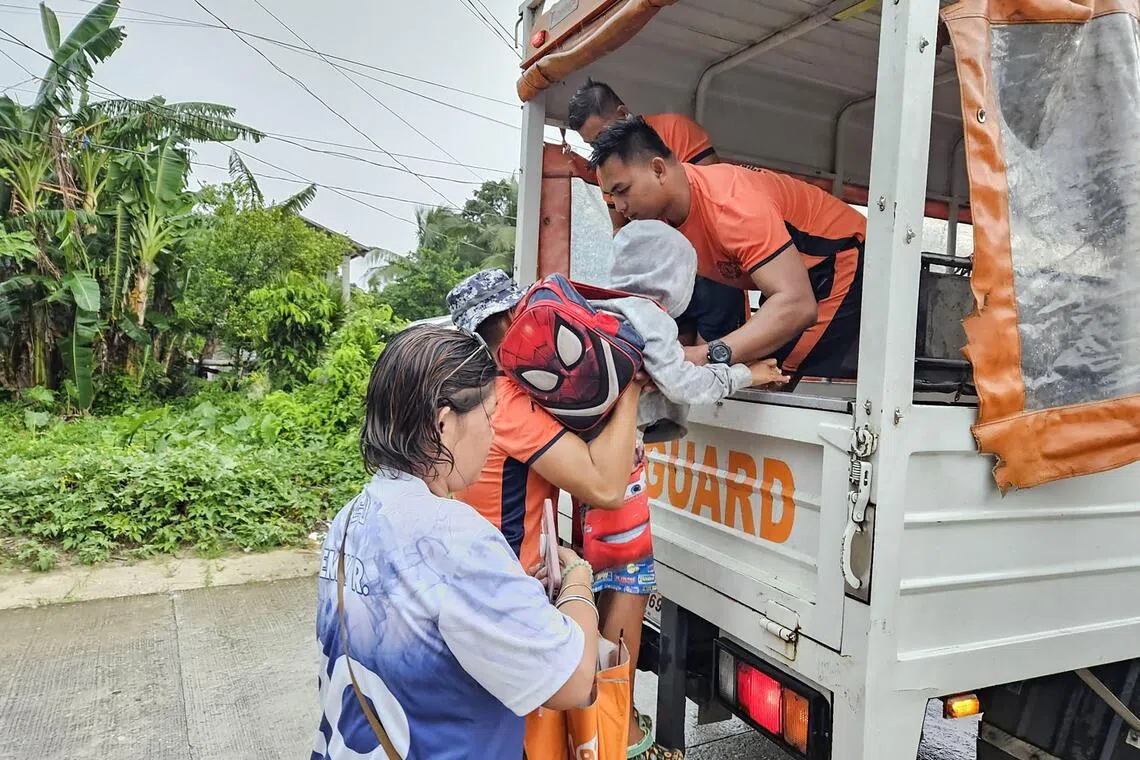Tens of thousands shelter as Typhoon Kalmaegi slams into the Philippines
Sign up now: Get insights on Asia's fast-moving developments

Coast guard personnel helping to evacuate residents of Guiuan town in central Philippines as Typhoon Kalmaegi approaches with 140kmh winds.
PHOTO: AFP
Follow topic:
MANILA – More than 150,000 people took shelter in coastal provinces of the Philippines on Nov 3 as powerful Typhoon Kalmaegi made landfall in a region hit by some of the country’s deadliest storms.
The typhoon, with winds of 150kmh and gusts of up to 205kmh, made first contact in Dinagat Islands province, part of the Visayas island chain, before 11pm, the national weather service said.
Barely an hour earlier, 34-year-old Miriam Vargas sat in the darkness with her two children after the storm knocked out their electricity.
“As of now, there is strong rain and winds starting. We’re sitting on the stairs and praying while trying to gauge the typhoon’s strength,” she said. “The wind is whistling, and there are sounds of things falling. The electricity went out about an hour ago, and we cannot see anything.”
“Evacuations are ongoing in Palo and Tanauan,” said Leyte disaster official Roel Montesa, naming two of the towns hardest hit by storm surges in 2013, when Super Typhoon Haiyan killed more than 6,000 people.
Thousands of residents have also been evacuated since Nov 2 on neighbouring Samar island, where 3m surges are predicted, according to civil defence official Randy Nicart.
“Some local governments are resorting to forced evacuations, including Guiuan town, where the storm is likely to make landfall,” he said.
Already the 20th storm
As of 8pm, “close to 156,000 individuals” had been preemptively evacuated, Office of Civil Defence deputy administrator Rafaelito Alejandro told a press briefing.
The Philippines is hit by an average of 20 storms and typhoons each year, routinely striking disaster-prone areas where millions live in poverty.
With Kalmaegi, the archipelago country has already reached that average, state weather service specialist Charmaine Varilla said, adding that at least “three to five more” storms could be expected by December’s end.
Just south of Leyte, in Dinagat Islands province, Governor Nilo Demerey said 10,000 to 15,000 people have been pre-emptively moved to safer areas.
“We have been implementing pre-emptive evacuations for the past two days, while there is time,” he said.
Disaster official Joy Conales said residents of Dinagat’s Loreto town were told to evacuate to higher ground.
The town has a one-storey-tall “wave breaker” dike intended to protect its centre from big waves.
Scientists warn that storms are becoming more powerful
Ms Varilla said higher numbers of cyclones typically accompany La Nina, a naturally occurring climate pattern that cools surface temperatures in the central and eastern equatorial Pacific Ocean.
The Philippines was hit by two major storms in September, including Super Typhoon Ragasa

